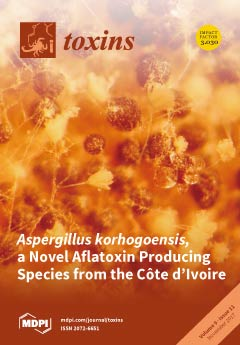Aflatoxicosis is a grave threat to the poultry industry. Dietary supplementation with antioxidants showed a great potential in enhancing the immune system; hence, protecting animals against aflatoxin B
1-induced toxicity. Grape seed proanthocyanidin extract (GSPE) one of the most well-known and powerful antioxidants. Therefore, the purpose of this research was to investigate the effectiveness of GSPE in the detoxification of AFB
1 in broilers. A total of 300 one-day-old Cobb chicks were randomly allocated into five treatments of six replicates (10 birds per replicate), fed
ad libitum for four weeks with the following dietary treatments: 1. Basal diet (control); 2. Basal diet + 1 mg/kg AFB
1 contaminated corn (AFB
1); 3. Basal diet + GSPE 250 mg/kg; (GSPE 250 mg/kg) 4. Basal diet + AFB
1 (1 mg/kg) + GSPE 250 mg/kg; (AFB
1 + GSPE 250 mg/kg) 5. Basal diet + AFB
1 (1mg/kg) + GSPE 500 mg/kg, (AFB
1 + GSPE 500 mg/kg). When compared with the control group, feeding broilers with AFB
1 alone significantly reduced growth performance, serum immunoglobulin contents, negatively altered serum biochemical contents, and enzyme activities, and induced histopathological lesion in the liver. In addition, AFB
1 significantly increased malondialdehyde content and decreased total superoxide dismutase, catalase, glutathione peroxide, glutathione-S transferase, glutathione reductase activities, and glutathione concentration within the liver and serum. The supplementation of GSPE (250 and 500 mg/kg) to AFB
1 contaminated diet reduced AFB
1 residue in the liver and significantly mitigated AFB
1 negative effects. From these results, it can be concluded that dietary supplementation of GSPE has protective effects against aflatoxicosis caused by AFB
1 in broiler chickens.
Full article






